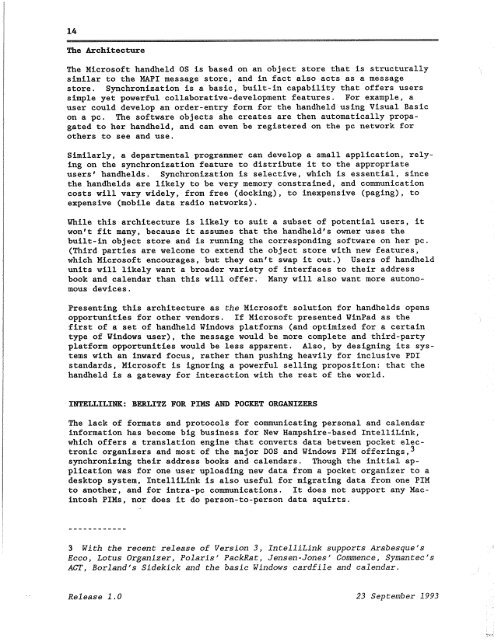23 September 1993 - Cdn.oreilly.com
23 September 1993 - Cdn.oreilly.com
23 September 1993 - Cdn.oreilly.com
You also want an ePaper? Increase the reach of your titles
YUMPU automatically turns print PDFs into web optimized ePapers that Google loves.
14<br />
The Architecture<br />
The Microsoft handheld OS is based on an object store that is structurally<br />
similar to the MAPI message store, and in fact also acts as a message<br />
store. Synchronization is a basic, built-in capability that offers users<br />
simple yet powerful collaborative-development features. For example, a<br />
user could develop an order-entry form for the handheld using Visual Basic<br />
on a pc. The software objects she creates are then automatically propagated<br />
to her handheld, and can even be registered on the pc network for<br />
others to see and use.<br />
Similarly, a departmental programmer can develop a small application, relying<br />
on the synchronization feature to distribute it to the appropriate<br />
users' handhelds. Synchronization is selective, which is essential, since<br />
the handhelds are likely to be very memory constrained, and <strong>com</strong>munication<br />
costs will vary widely, from free (docking), to inexpensive (paging), to<br />
expensive (mobile data radio networks).<br />
While this architecture is likely to suit a subset of potential users, it<br />
won't fit many, because it assumes that the handheld's owner uses the<br />
built-in object store and is running the corresponding software on her pc.<br />
(Third parties are wel<strong>com</strong>e to extend the object store with new features,<br />
which Microsoft encourages, but they can't swap it out.) Users of handheld<br />
units will likely want a broader variety of interfaces to their address<br />
book and calendar than this will offer. Many will also want more autonomous<br />
devices.<br />
Presenting this architecture as the Microsoft solution for handhelds opens<br />
opportunities for other vendors. If Microsoft presented WinPad as the<br />
first of a set of handheld Windows platforms (and optimized for a certain<br />
type of Windows user), the message would be more <strong>com</strong>plete and third-party<br />
platform opportunities would be less apparent. Also, by designing its systems<br />
with an inward focus, rather than pushing heavily for inclusive PDI<br />
standards, Microsoft is ignoring a powerful selling proposition: that the<br />
handheld is a gateway for interaction with the rest of the world.<br />
INTELLTLINK: BERLITZ FOR PINS AND POCKET ORGANIZERS<br />
The lack of formats and protocols for <strong>com</strong>municating personal and calendar<br />
information has be<strong>com</strong>e big business for New Hampshire-based IntelliLink,<br />
which offers a translation engine that converts data between pocket electronic<br />
organizers and most of the major DOS and Windows PIM offerings,3<br />
synchronizing their address books and calendars. Though the initial application<br />
was for one user uploading new data from a pocket organizer to a<br />
desktop system, IntelliLink is also useful for migrating data from one PIM<br />
to another, and for intra-pc <strong>com</strong>munications. It does not support any Macintosh<br />
PIMs, nor does it do person-to-person data squirts.<br />
3 With the recent release of Version 3, IntelliLink supports Arabesque's<br />
Ecco, Lotus Organizer, Polaris' PackRat, Jensen-Jones' Commence, Symantec's<br />
ACT, Borland's Sidekick and the basic Windows cardfile and calendar.<br />
Release 1.0 <strong>23</strong> <strong>September</strong> <strong>1993</strong>

















